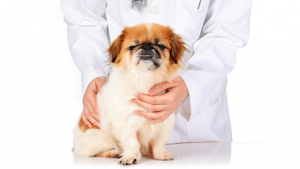The Six Most Common Dog Health Issues
Your dog is your best friend, and we all want to keep our friends in the best of health so they can spend as much time with us as possible. There are many health issues that can effect your dog, and here are the six most common health issues:
1. Ear Infections: This is probably the most common health issue in dogs, and is generally caused by yeast, bacteria, ear mites or hair growth deep in the ear canal that causes itching and a resulting infection. It is important to take your dog to the veterinarian if they have an ear infection because there is a good chance that permanent damage can occur if your dog is left alone scratching their ears. Many dogs will scratch until damage has occurred to the skin and ear canal, and shaking their head can also rupture blood vessels. Untreated bacterial and yeast infections can result in permanent deafness.Things to look for if you believe your dog might have an ear infection are:
Shaking their head or tilting it
Odor coming from ears
Scratching ears
Poor balance
Unusual eye movement
Redness or swelling of ears or ear canals
Any discharge from ears.
2. Tapeworms, Hookworms, Roundworms or Whipworms: These parasites are internal and cannot be noticed by looking at your dog. If left untreated, worms can be fatal in puppies. The best thing to do if you expect that your dog might have worms is to take them to a veterinarian for treatment. Typical treatments include an oral medication and a follow up. Do not try to treat worms yourself. Here are symptoms of worms:
Diarrhea
Loss of weight
Appetite changes
Dry or rough coat
Scooting
Poor appearance
3. Fleas: Fleas are very uncomfortable for dogs, and a single flea can breed to over 1,000 fleas in less than three weeks. Fleas can cause a severe allergic reaction in dogs and even anemia from blood loss. Scratching the areas of flea bites can lead to skin damage and infection. Symptoms of fleas include:
Scratching, licking, or biting skin
Hair loss
Hot spots
Allergic dermatitis
Tapeworms (these are carried by fleas)
Flea dirt on skin(this looks like small black dots)
4. Hot Spots. These are areas that are very itchy for dogs and will generally produce vigorous scratching as they attempt to get rid of the itching feeling. Hot spots are generally caused by moist allergic dermatitis, which is an acute skin infection. Hot spots can also be caused by flea bites and other conditions. The treatment for hot spots usually involves shaving the area and treating with topical ointments or anti-inflammatory drugs.
5. Vomiting. If your dog is vomiting repeatedly, get them to the veterinarian immediately as it can quickly lead to dehydration and can be fatal. It is also generally a signal of a deeper condition which is causing the body to shut down and not be able to hold food or water. Vomiting is usually caused by infection or intestinal parasites to pancreatitis, kidney failure, heatstroke, or poisoning. If your dog is lethargic, vomiting or acting uncomfortable, a trip to the vet immediately is necessary.
6. Diarrhea: Diarrhea in dogs can also cause dehydration quite quickly and can be fatal if untreated. It is also generally a sign of a deeper underlying condition such as stress, infections like parvo virus, intestinal parasites, and food problems. If your dog has liquid or loose stool for more than 1 day, take them to the veterinarian for an examination.

 When you got your dog, you probably went through a process to enclose your yard as much as possible to keep your dog from running away. While this is certainly a positive thing to do, it is also important to monitor your yard for changes that could potentially result in harm to your pet. There are several things to specifically look for, but it is a good idea to walk around in your yard every few days looking for any changes that may have risks associated with them. Dogs are curious and will interact with nearly everything in their environment, especially if they view it as an intruder into their space. Here are a few things to scan your yard for regularly:
When you got your dog, you probably went through a process to enclose your yard as much as possible to keep your dog from running away. While this is certainly a positive thing to do, it is also important to monitor your yard for changes that could potentially result in harm to your pet. There are several things to specifically look for, but it is a good idea to walk around in your yard every few days looking for any changes that may have risks associated with them. Dogs are curious and will interact with nearly everything in their environment, especially if they view it as an intruder into their space. Here are a few things to scan your yard for regularly: There are many animal hospitals in Las Vegas, and many fine veterinarians working within those facilities. We strongly encourage you to choose the best facility that you can afford, which is convenient to your home as well as being a caring and knowledgeable facility that has your pet’s best interests in mind. Convenience to your home is very important in that if it is not convenient there is a good chance that you will not take your pets in to see the vet for regular checkups as much as if it were closer, so we encourage you to find the clinic that is not only convenient but that makes you feel the most comfortable that your pet is in good hands. As long as you are willing to drive a few extra miles, sometimes the better choice maybe a little less convenient, but in the end, choosing the veterinarian that you will make the regular visits to is key. We are a different and new type of animal hospital in Las Vegas, in that our clinic was built on the philosophy of keeping your pet healthy, instead of just treating them when they are sick. We feel this makes us a better choice for your pet, even if it is a little less convenient for you.
There are many animal hospitals in Las Vegas, and many fine veterinarians working within those facilities. We strongly encourage you to choose the best facility that you can afford, which is convenient to your home as well as being a caring and knowledgeable facility that has your pet’s best interests in mind. Convenience to your home is very important in that if it is not convenient there is a good chance that you will not take your pets in to see the vet for regular checkups as much as if it were closer, so we encourage you to find the clinic that is not only convenient but that makes you feel the most comfortable that your pet is in good hands. As long as you are willing to drive a few extra miles, sometimes the better choice maybe a little less convenient, but in the end, choosing the veterinarian that you will make the regular visits to is key. We are a different and new type of animal hospital in Las Vegas, in that our clinic was built on the philosophy of keeping your pet healthy, instead of just treating them when they are sick. We feel this makes us a better choice for your pet, even if it is a little less convenient for you.